Choosing an electric heated towel rail with a thermostat

Electric heated towel rails with a thermostat - with and without a shutdown timer, white, metallic and other colors, have gained popularity among owners of individual housing and city apartments. They allow you to maintain a comfortable temperature in the room even during periods of disconnection of the main heat supply, and the design of the devices is as simple and convenient to use as possible. When deciding which electric heated towel rail is better to choose, it is worth considering all the advantages of rotary and classic, oil and other models in order to find the best option for installation in the bathroom.
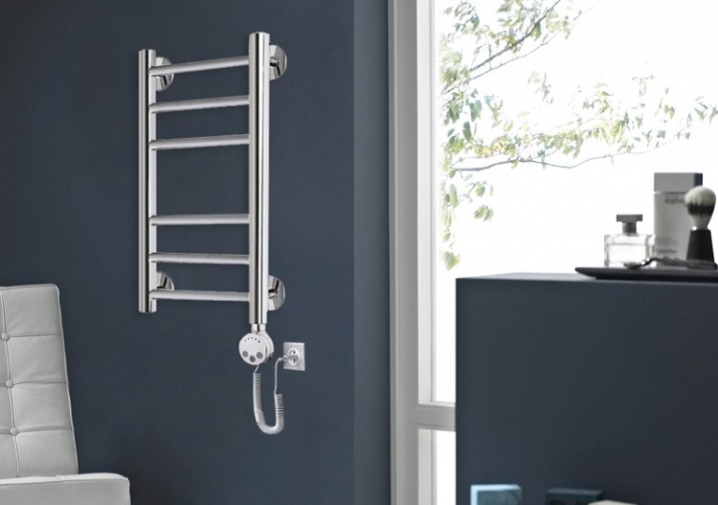
Peculiarities
Modern bathroom fittings differ markedly from the classic plumbing fixtures of the past. Bulky pipes on the walls were replaced by electric heated towel rails with a thermostat - stylish, graceful, not depending on the seasonal supply of hot water in the pipes. Such devices use different heating methods, provide effective maintenance of the desired air temperature in the room.
The main feature of this type of heated towel rail is the presence of a thermostat. It is initially supplied by the manufacturer as a kit, fully complies with all the specified operating parameters of a particular product. Heated towel rails with a thermostat are made of metal - stainless, colored or black, with a protective coating.
The standard heating range in them is limited to 30-70 degrees Celsius.

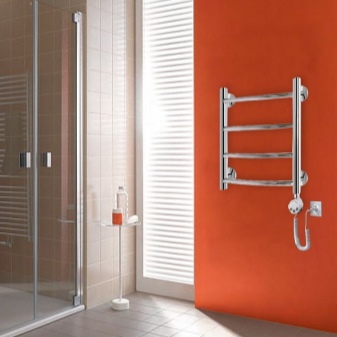
Views
By the type of their design and the method of heating used, all electric heated towel rails equipped with a thermostat are divided into 2 large groups.
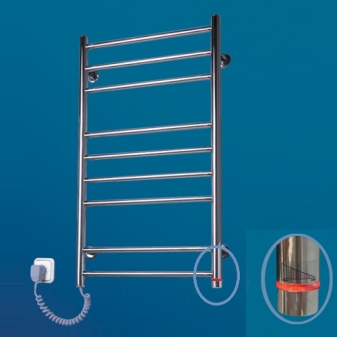
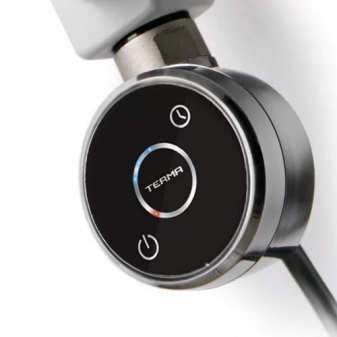
Based on heating elements
The most common type of electric heated towel rails with a thermostat involves the use of a tubular part as a heating device. The heating element increases the temperature of the liquid circulating inside the closed circuit. By the type of coolant, the following types of devices are distinguished:
- water;
- oil;
- on distillate;
- on antifreeze.
The heating element itself can also have a different design. Some options are considered universal. In winter, they function in the general heating system, using a heat carrier in the form of hot water supplied through the mains. In summer, heating is controlled by a heating element.
"Wet" devices are cheaper, but they require installation in a strictly defined position.
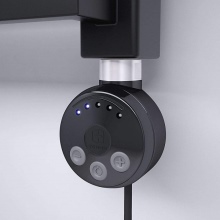
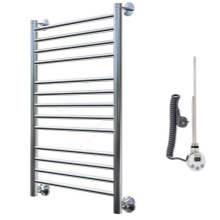

The big advantage of this type of electric heated towel rail is the absence of restrictions on the size, design form. The device can be positioned vertically and horizontally, have an unlimited number of bends. In the course of its operation, it is possible to significantly save electricity, since the coolant circulating inside helps to preserve heat for a longer period. If the heating element fails, it is quite easy to replace it yourself.
The disadvantages of such a heating device are also obvious. Since the thermostat and the heating element are located nearby, situations often arise when the line heats up unevenly. The part close to the heat source remains hot. More distant areas turn out to be barely warm.This disadvantage is typical for serpentine S-shaped models, but multi-section "ladders" are deprived of it, since they provide fluid circulation during operation.
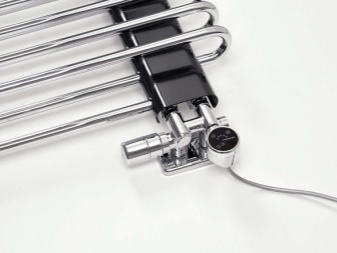
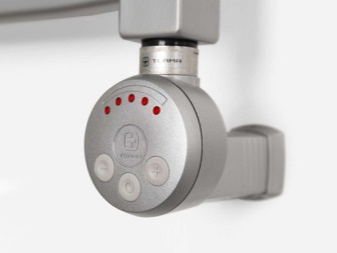
With heating cable
The principle of operation of the device is similar to that used in underfloor heating systems. The cable heated towel rail is equipped with a wired heating element placed in the hollow tube of the body. When connected to the network, the device heats up to the level set by the thermostat. The complexity of the installation lies in the fact that the controller has to be mounted even at the stage of cable laying. In addition, in terms of its service life, it is noticeably inferior to oil and water analogues.
Heated towel rails of this type provide an even supply of heat. The device heats the housing, consisting of tubes, over the entire surface. This is important when drying towels and other textiles. In addition, the device completely eliminates the possibility of overheating - the cable in this design is limited to a set of temperatures in the range from 0 to 65 degrees. In the absence of such a controller, devices fail much more often.
The obvious disadvantages of heated towel rails with a heating cable include the limited design. Such devices are exclusively S-shaped or in the form of the letter U, turned on its side. This is due to the fact that the cable can only be bent within certain limits, otherwise the wire will be damaged. If the installation standards are violated, voltage may be applied to the device body under certain circumstances - this makes the heating device quite dangerous to operate.
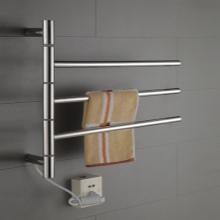

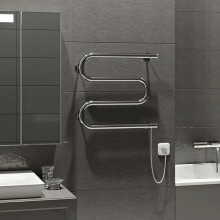
Dimensions and design
An electric heated towel rail, depending on its design, can be located on a wall or mobile support vertically or horizontally. This directly affects its dimensions. For example, popular "ladders" are oriented exactly vertically, their width varies from 450 to 500 mm with a length of 600-1000 mm, in some multi-section models it reaches 1450 mm. Horizontal models have different parameters. Here the width varies from 650 to 850 mm with a section height of 450-500 mm.
As for the design, a lot depends on the preferences of the owner himself. For example, the floor-standing version can be used in the summer as an addition to the main one built into the hot water supply line. Suspended models are narrow and wide, they can have swivel sections that change their position within 180 degrees. They are convenient for drying laundry in different planes, and provide a more rational use of the area of the room.
Exterior design matters too. If you are purchasing a device made of black steel, painted in white, black, silver, you should focus on the overall design of the bathroom. The matte look of the decor is appropriate in classic interiors, the “Soft touch” coatings, reminiscent of rubber, look interesting - many manufacturers have them. The shine of gloss and stainless steel will be appropriate for high-tech aesthetics.
Non-ferrous metals - bronze, brass, are used in the manufacture of premium-class heated towel rails.
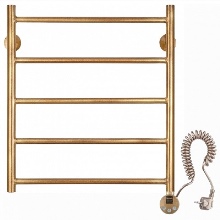

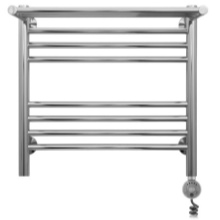
Rating of the best models
Models of heated towel rails with a thermostat and an electric type of heating element presented on the domestic markets are supplied both from Germany, Great Britain, and from Russia. The difference in price between them is quite significant, but the quality of workmanship does not always differ dramatically. Buyers most often make the choice based on the heating temperature range, the degree of safety of the device, the number of electronic components - the option with a shutdown timer will cost more than usual.
The most relevant and demanded electric heated towel rails with a thermostat are collected in the ranking of the best models.

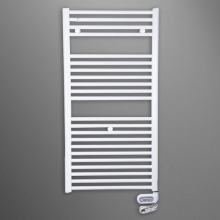
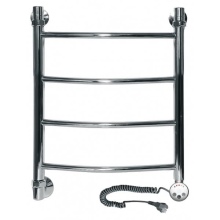
- Zehnder Toga 70 × 50 (Germany). Multi-section vertically oriented heated towel rail with pendant mount and electric cable, supplemented with a standard plug.The connection is exclusively external, the type of construction is "ladder", the product is made of chrome-plated steel. In addition to the thermostat, there is a timer, antifreeze acts as a coolant, the power of the model reaches 300 watts. 17 separate sections allow you to hang a lot of laundry, high-precision welding ensures the tightness of the tubular elements.
- Margaroli Vento 515 BOX (Italy). Modern brass heated towel rail with a swivel section, the shape of the body is U-shaped, various options for decorative spraying are possible - from bronze to white. The model has a hidden connection type, power 100 W, capable of heating up to 70 degrees. The heated towel rail belongs to the category of dry systems, does not involve the circulation of the coolant, it is hung on the wall.
- "Nika" ARC LD (r2) VP (Russia). Heated towel rail “ladder” with 9 sections and thermostat. The model is made of stainless steel with a chrome-plated finish, belongs to the "wet" type, equipped with a heating element, suitable for space heating. The construction is quite heavy, weighing almost 10 kg.
- Terminus "Euromix" P8 (Russia). 8-section heated towel rail from the leader of the domestic market, has a "ladder" design type, slightly protruding on the arcs. The model supports open and hidden connection, there are 4 heating modes from the cable, with a limit of 70 degrees. The product has a modern design, the electronic unit not only regulates the temperature, but also remembers its last values.
- Lemark Melange P7 (Russia). Stylish heated towel rail with powder mottled painting has a "wet" type of construction with a coolant in the form of antifreeze. Heating power reaches 300 W, power supply from a regular household network makes it easy to connect. The sections have a square and oval cross-section, which, due to their combination, increases the heat transfer of the device. Wall mount, telescopic.
- Domoterm "Salsa" DMT 108E P6 (Russia). W-shaped 6-section heated towel rail with swivel modules. The ultra-compact design is wall-mounted and plugs into your regular household network. Made of chrome-plated stainless steel with electrical cable inside. The power of the device is 100 W, the maximum heating is possible up to 60 degrees.
- Laris "Zebra Standard" ChK5 (Ukraine). Compact 5-section model with shelf. It has a suspended type of construction, it is connected to a regular household outlet. Made of powder coated stainless steel. The model has a dry cable design, power - 106 W, heats up to 55 degrees. It is an economical solution for drying laundry in a small bathroom.
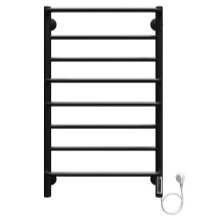
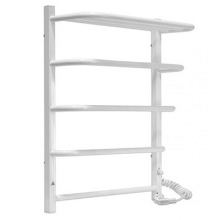
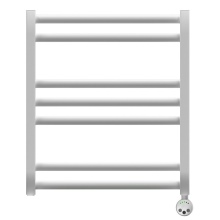
This list can be expanded with other models of the indicated brands. Floor-standing design options are rare, as they are not in high demand.
Suspended models represent the bulk of the goods on the electric heated towel rail market.
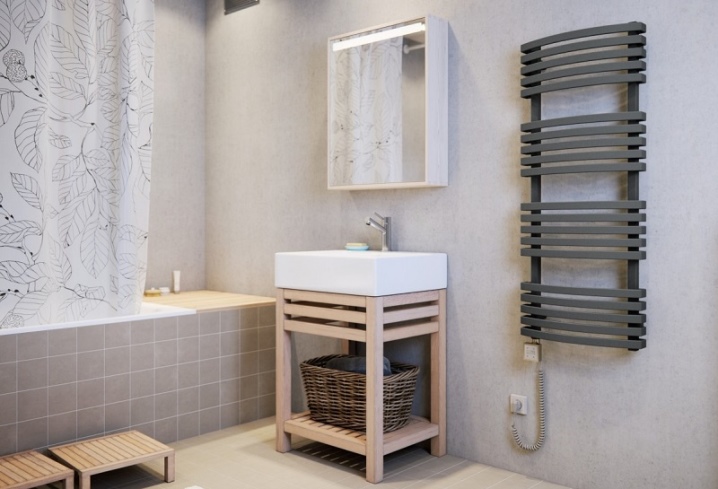
How to choose?
When choosing an electric heated towel rail for a bathroom, you should pay attention to both the features of the thermostat and the basic parameters of the device itself. Among the most important criteria are the following points.
- Heating type. "Wet" models have a closed loop, they are completely autonomous, they are not connected to a common line through which hot water is supplied. They require installation in a strictly defined position, have a wide range of options for power and performance. Dry-heated appliances use cables that are routed inside pipes.
They do not retain heat, cool instantly after shutdown, and are installed in different positions.
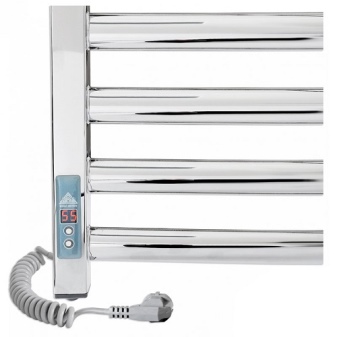
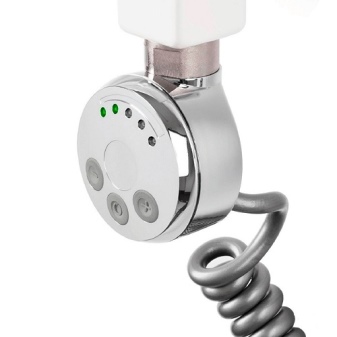
- Connection method. Allocate open - with a classic plug, plugged into an outlet outside the bathroom, as well as closed. In the second case, the wiring is mounted directly to the power supply, switching on and off, control over the operation of the equipment occurs using an electronic panel or mechanical elements (buttons, levers, rotating modules).
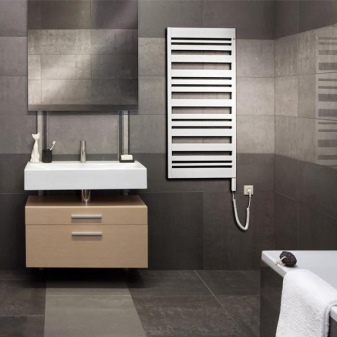
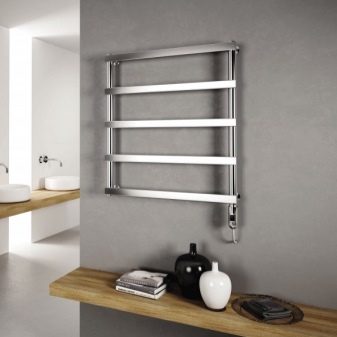
- Body material. Almost any metal with high thermal conductivity is suitable for cable heated towel rails. For models with heating elements, the tightness of the device is of great importance, respectively, the material must resist corrosion well. The best choice would be stainless steel or non-ferrous metal (aluminum, copper, brass).
Budget models usually have a case of coated ferrous metals.
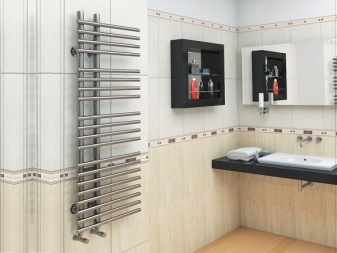
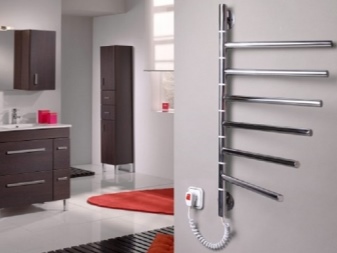
- Power and energy consumption. The standard range for electric towel warmers is 100 to 2000 watts. The amount of energy consumed by the appliance can significantly affect the size of utility bills. "Dry" - cable models - are more economical, consume about 100-150 watts.
"Wet" ones have a wider range of temperatures and power, they can be used not only for drying clothes, but also for heating the room.


- Product shape. For heated towel rails with a coolant circulating inside, the shape of a "ladder" with many cross bars is well suited. Cable cables are often made in the form of a "snake" or a letter U turned on its side. They are not so spacious, but rather convenient in operation, more like standard designs without additional heating.


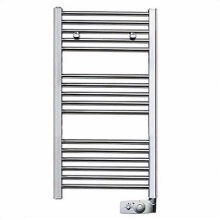
- Availability of additional options. Swivel-folding heated towel rails allow you to vary the position of the sections in space. Their elements can be deployed in different planes.
The auto-off function will prevent overheating, protect the device from failure in the event of a power surge.
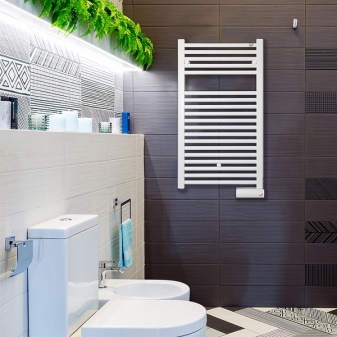
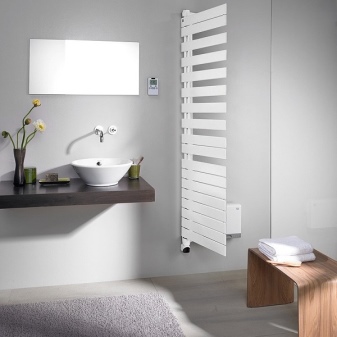
- Number of bars. It can vary from 2-4 to 9 or more. The more laundry you plan to dry, the higher the optimal amount will be. In this case, it is worth considering the load on the device.
It may have weight restrictions.
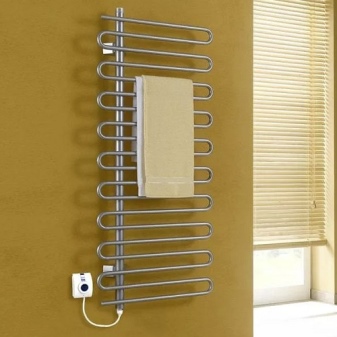
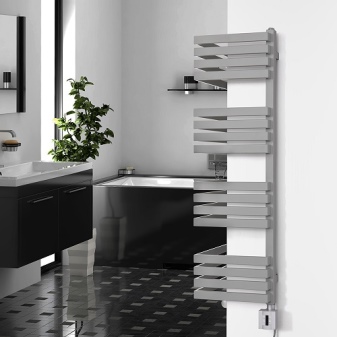
It is worth paying special attention to the calculation of the power of the device. If the device is purchased exclusively for drying clothes, the option with heating indicators of 100-200 watts will suffice. When using a heated towel rail as a constant source of heat in the bathroom, a certain amount of energy must fall on every 1 m2. The standard rate is 140 W / m2.
It is enough to multiply this indicator by the area of the bathroom, and then round it up.
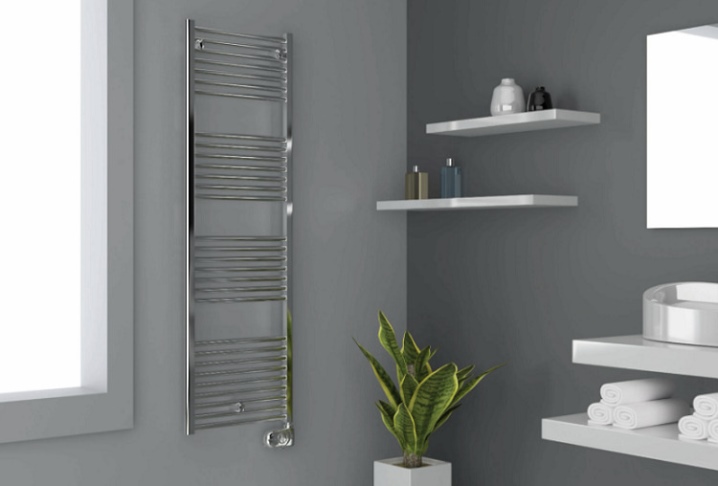













The comment was sent successfully.